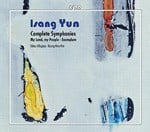2(II=picc).2(II=corA).2.2-4.2.2.1-timp.perc(min.2):SD/BD/tamb/xyl/2tgl/vib/5gong/5cym/5tom-t/2tam-t/glsp/5tpl.bl-strings
Abbreviations (PDF)
Bote & Bock
Between 1982 and 1987 !sang Yun composed an interconnected series of five contrasting symphonies. Although the five symphonies differ in instrumentation, formal structure, and content, they maintain an ideal relation and may even be said to constitute a cycle. Symphony I (1982-83, four movements, ca. forty-five minutes) and its apocalyptic first movement warn of a nuclear disaster. Symphony II (1984, three movements, ca. thirty minutes) is more reserved in matters of instrumentation. If, as Yun has stated, Symphony I is directed from composer to society, then Symphony II is oriented in the opposite direction, from society to composer. Yun has termed his even shorter Symphony III (1985, one movement) "philosophical." Here a successive rotation of conflicting tonal worlds brings heaven, earth, and humanity into relation in the name of Tao. Although Symphony IV "Singing in the Dark" (1986) is somewhat Ionger than Symphony II, it has only two movements and is modeled on Korean poetic declamation. There are two broad developments of ascent, and the song of the strings and, in the second movement, of the oboe undergoes repeated, brutal interruption. Yum draws on poems by Nelly Sachs in his Symphony V (1987, five movements, ca. one hour long) for large orchestra and baritone solo and spans a full range of dramaturgical possibilities: the remembrance of times past, the call to reconciliation, and the goal of peace.
Yun composed his Symphony II from 21 May to 17 October 1984. lt was premiered by the Berlin Philharmonie Radio Symphony Orchestra under Jesús López Cobos in Berlin Philharmonie Hall on 9 December 1984. ln this work, more so than in Yun's other symphonies, the sound organization is conveyed in the mostly simultaneous overlapping of the rival sound Ievels. Here Yun is thinking of symbolic processes: the world of the strings represents positive forces, while the natural force of the percussion and brass instruments suggests demonic and destructive powers. The woodwinds form an indeterminate, oscillating sound block; they side with the brass instruments and the strings and thus take on mediating and neutralizing functions.
In Symphony II Yun views the earth from a very great distance, from an almost planetary remove. Here he is guided not so much by principles of transformation in the sense of an audible shift as by principles of transmutation. According to the Basel music historian and ethnologist Hans Oesch, in East Asian thought "transmutation" involves "a cycle of phenomena in mutual succession and with an eventual return to their point of departure" (1987). Yun also involves features of the three movements of the European symphonic genre in this process.
The first movement has the effect of a grand-scale, monumental crescendo. The slow movement offers a subdued contrast, and the triumphal finale, ruled by the string sound, seems to portend a good outcome.
For all the restless movement hardly admitting of a pause, for all the disputatious, triumphant finality of imperious torward progress, the mighty energies driving the score seem to idle. Yun has also supplied a stationary affect to the third movement, a speeding presto leading nowhere or only from c sharp to c sharp . One cannot help but think that Yun is pleading against the ways of the world by imitating them. If this is so, then the vision of an extraplanetary perspective has found its fitting musical expression.
Walter-Wolfgang Sparrer (translated by Susan Marie Praeder)

Filharmonia Pomorska Bydgoszcz / Takao Ukigaya
CPO 999 165-2
